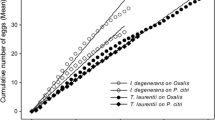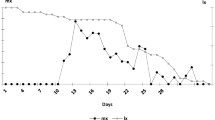Abstract
Experiments on development of Amblyseius Longispinosus Evans (Acari:Phytoseiidae) as influenced by castor pollen as an alternate food and its interaction with sorghum mite, Oligonychus indie us Hirst (Acari:Tetranychidae) were conducted under laboratory conditions. A. longispinosus showed poor growth on castor pollen. Female and male developmental periods were 2.6 ± 0.30 and 2.42 ± 0.21 days on spider mites, 2.70 ± 0.89 and 2.68 ± 0.39 days on spider mites + castor pollen and 5.12 ± 2.03 and 3.89 ± 1.80 days on castor pollen alone, respectively.
At interaction A. longispinosus suppressed populations of O. indicusat 1:10, 1:20, 1:30, 1:40 and 1:50. Prey elimination was on 12th day in 1:10, 18th day in 1:20, 20th day in 1:30, 24th day in 1:40 and on 30th day in 1:50 ratio.
Résumé
Des expérience ont été conduites au laboratoire sur le développement iï Amblyseius longispinosus Evans (Acari: Phytoseiidae) tel qu’influencé par le pollen de ricin qui est une source alternative de nourriture et ses interactions avec l’acarien du sorgho, Oligonychus Indicus Hirst (Acari: Tetranychidae). A. longispinosus a montré une faible croissance avec le pollen de ricin. Les périodes de développement du mâle et de la femelle ont été de 2.6 ± 0.30 et 2.24 ± 0.21 jours pour l’acarien prédateur, de 2.70 ± 0.89 et 2.68 ± 0.39 jours pour l’acarien tisserand + pollen de ricin et de 5.12 ± 2.03 et 3.89 ± 1.80 jours pour le pollen de ricin seul respectivement.
Concernant les interactions, A. longispinosus a éliminé des populations de O. indicus dans un rapport de 1:10,1:20.1:30,1:40 et 1:50. La disparition de la proie survenait au 12e jour, 18e jour, 20e jour, 24e jour et 30e jour correspondant respectivement aux ratios ci-haut.
Similar content being viewed by others
References
Akimov, I. A. and Kolodochka, L. A. (1983) Amblyseius Longispinosus (Evans) (Parasitiformis: Phytoseiidae) a potential predatory mite for use in biological control. West. Zool. 4, 78–81.
Borah, D. C. and Rai, P. S. (1989) Potentiality of Amblyseius ovalis (Acarina: Phytoseiidae) as biological control agent on Bemisia tabaci (Homoptera: Aleyrodidae). In Progress in Acarology (Edited by Channa Basavanna, G.P. and Viraktamath C.A.), pp. 375–380. Oxford and IBH publishing Co. Pvt. New Delhi.
Chant, D. A. (1959) Phytoseiid mites (Acarina) Part-I. Binomics of seven species in southeastern England. Part II. A taxonomic review of the family Phytoseiidae, with description of 38 new species. Can. Entomol. 12, p. 166.
El Badry, E. A. and el Banhawy, E. N. (1968) The effect of non-prey food, mainly pollen on the development, survival and fecundity of Amblyseius gossypii (Acarina:Phytoseiidae). Entomol. Exp. Appl. i 11, 269–272.
Hoyt, S. C. (1970) Effect of short feeding periods by Metaseiulus occidentalis on fecundity and mortality of Tetranychus mcdanieli. Ann. Entomol. Soc. Am. 63, 1382–1384.
Mallik, B. (1974) Biology of Amblyseius Longispinosus (Evans) (Acarina:Phytoseiidae) and Tetranychus ludeni Zacher (Acari:Tetranychidae) and interaction between them. M.Sc.(Agric) thesis, University of Agricultural Sciences, Bangalore.
Manjunatha M. (1988) Bioecology of sorghum spider mite Oligonychus Indicus (Hirst) (Acari:Tetranychidae) and estimation of crop losses due to it in sorghum. Ph. D. thesis. University of Agricultural Sciences, Bangalore.
McMurtry, J. A. and Scriven G. T. (1964) Studies on the feeding and development of Amblyseius hibisci (Evans) (Acari:Phytoseiidae) on various food substances. Ann. Entomol. Soc. Am. 57, 649–655.
Mori, H. (1969) The influence of prey density on the prédation of Amblyseius Longispinosus (Evans) (Acarina:Phytoseiidae). Proc. 2nd Int. Cong. Acarology, Sutton, Bonnington, England Akad. Kiado, Budapest, pp. 149–153.
Neelu Nangia and Channa Basavanna, G. P. (1982) Effect of castor pollen on the density of Typhlodromips tetranychivorus Gupta (Acari:Phytoseiidae). Indian, J. Acar. 7, 1–4.
Puttaswamy (1978) Studies on the ecology of Tetranychus ludeni Zacher (Acari:Tetranychidae) and its interaction with the predator Typhlodromips tetranychivorus Gupta (Acari:Phytoseiidae), Ph.D. thesis, University of Agricultural Sciences, Bangalore, p. 204.
Saito, Y. and Mori, H. (1975) The effects of pollen as an alternate food for three species of phytoseiid mites (AcarinaiPhytoseiidae). Mem. Fac. Agric. 9, 236–246.
Author information
Authors and Affiliations
Additional information
The paper is part of a Ph.D. thesis of the first author submitted to the University of Agricultural Sciences, Bangalore.
Rights and permissions
About this article
Cite this article
Manjunatha, M., Puttaswamy Development of Amblyseius Longispinosus (Acari:Phytoseiidae) as Influenced by Castor Pollen and its Interaction with Oligonychus Indicus (Acari:Tetranychidae). Int J Trop Insect Sci 14, 611–614 (1993). https://doi.org/10.1017/S1742758400018002
Received:
Accepted:
Published:
Issue Date:
DOI: https://doi.org/10.1017/S1742758400018002




